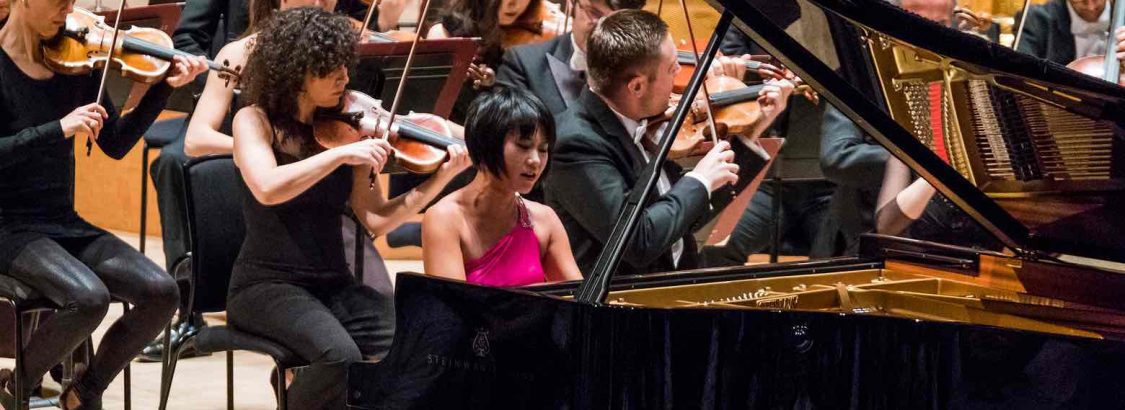Douglas L. Dutton, Seen and Heard International
Say what you will about the media phenomenon of Yuja Wang and her virtuosic show-womanship in performing the three Bartók Concertos over seven evenings, but even the most peevish music lover is compelled to admit that she is at the pinnacle of the pianistic world. No one ought to be crowned ‘best’ pianist anymore – there are simply too many individual approaches, too many stylistic options and manners to proclaim a ‘best’ – but what she played in Los Angeles, seven concerts over a ten-day span, was a feat that matches any by Sir Edmund Hillary, Usain Bolt or Michael Jordan. She made believers of us all.
Bartók’s three concertos don’t follow any grand plan or have an overarching trajectory, except in reflecting the very private and personal aspirations of this great composer. What they do for listeners, however, is substantiate the growth and development of one of the twentieth century’s great composers in three tremendous works of intellectual depth and emotional complexity, works that carry a bold and original musical narrative forward.
Piano Concerto No.1 is the most brittle and nettlesome of the three. The hammering, repetitive motif of the first movement with its asymmetrical entries and jagged rhythmic insistence do not produce comfortable listening, but rather evoke a quasi-hysterical state of being. The repeated notes, unexpected cross-rhythms and splintered motifs likewise offer no relief. The second movement is a break from the din of the first, and the charms of the orchestration (no strings throughout) are at least a diverting respite from the preceding movement’s insistence and offer sly charm and subtle humor. No such luck in the final movement: the turbulence of the first movement returns with a vengeance, and no canon, fugue or dance (all three are actually found within) provides comfort or solace to this steely-eyed, bleak work. The pianist, with her dazzling agility, control and brilliance, paired with this phenomenal orchestra, thrilled the entire audience. There isn’t any ‘accompaniment’ in this or in the subsequent concertos: soloist and orchestra are partners in an undertaking of this magnitude.
When the audience rose to its feet, the applause was fairly apportioned to the entire performing ensemble, from the pianist to all the crucial individual players in the orchestra, and especially to the conductor, Gustavo Dudamel, whose achievement in keeping this ensemble not only on the same page but in the same nanosecond was phenomenal. I never would have believed that I would see and hear such an enthusiastic response from a Philharmonic audience to music like this.
In the first concerto, pianist Wang did something else that is a rarity these days: she read from the score and used a page-turner. If my observations are correct, the page-turner was there only as a psychological talisman: I didn’t see Wang actually look at the score, but perhaps she peeked when my attention was focused elsewhere.
The Bartók Second Piano Concerto, like the First, stunned listeners with the gestural declamations, rhythmic complexity and savage barbaro sections. Again, complicated dissonances ripple across the score between syncopated runs and finger-pummeled passages. The second movement opens and closes with a soft and distant string choral passage, a mystical and exquisite section that reminded me of Debussy’s La cathédrale engloutie mixed with Bluebeard’s dark castle. Wang’s phrasing coupled with her incredible pianissimo passages were both elegant and creepy.
The last movement is marked by brutish and diabolical complexity: a return to the first movement’s jarring insistence was brought to a close with a steady and insistent two-note tympani figure. The concerto is constructed in the famous Bartók ‘arch form’, and the rounded musical construction bestowed a formal design both ominous and mysterious, while conferring a sense of completeness.
The Disney Hall audience was once again on its feet, and this time the ovation was rewarded with three encores. The third movement from Mozart’s Sonata K.331, the famous ‘Turkish March’, barely got to its first phrase ending when Wang set off in a different direction: a string of improvised jazzy riffs, zigging and zagging in one stylistic direction after another. She then played a movement from the piano arrangement of Stravinsky’s Petroushka, and concluded with a tender, almost whispered transcription of Schubert’s haunting Gretchen am Spinnrade, which didn’t so much end as evanesce.
Bartók’s Piano Concerto No. 3, certainly more civilized that its two wild and wooly predecessors, is the last major work the composer finished shortly before his death in 1945. (Indeed, Bartók died only measures from completing the orchestration.) The music is still edgy, but with a decidedly more civilized mien. Wang played the central movement, marked ‘adagio religioso’ (its opening suggests Beethoven’s Hymn of Thanksgiving from his Op.132 String Quartet) with restraint and dignity that brought one member in my party to tears.
The encores for this go-round were, again, the Mozart, but with an entirely different improvisation from her earlier version; Prokofiev’s ‘Diabolical Suggestion’; the Carmen Fantasy, made famous by Vladimir Horowitz; and the Mélodie by Gluck from Orfeo ed Euridice. They were alternately raucous and exquisite.



